Modeling and Analysis of Intrabody Communication for Biometric Identity in Wireless Body Area Networks
Abstract
1. Introduction and Motivation
- Our research presents a study that integrates biometric identification techniques into the IBC system, utilizing channel gain influenced by individual physical characteristics (such as height, weight, and body composition) to enhance user identification and authentication from an experimental dataset containing data about real subjects. By using the KNN algorithm, we achieved an accuracy of 99.9%, demonstrating the potential for IBC to serve as reliable biometric identifiers.
- We proposed a novel IBC WBAN architecture that incorporates biometric identification functionalities, enhancing the performance and security of existing systems. This architectural advancement provides a framework for the development of future IBC-enabled devices and applications focused on personalized user experiences.
- By exploring the synergy between IBC technologies and biometric identification, our study addresses significant challenges in the realms of security and energy efficiency relevant to Industry 4.0. Our findings suggest pathways for the deployment of energy-efficient, secure WBANs within industrial settings, highlighting opportunities for health monitoring and workforce management.
- This analysis lays the groundwork for future studies assessing the applicability of IBC in diverse contexts.
2. Related Work
3. Materials and Methods
3.1. IBC
- Security: IBC provides a secure and private communication network, offering natural security and interference-resistant communication [32]. IBC requires a significantly lower operating frequency compared to RF systems. This means that signals are limited to human proximity, so data reading requires body contact [33].
- Frequency reuse: IBC forms a near-field communication network inside and around the human body. Consequently, it allows for the reuse of the same frequency band by other WBAN users.
3.2. IBC Identification
3.3. Signal Loss Measurement in IBC Channel
4. Data Analysis and IBC Channel Gain Characteristics
5. Modeling of IBC Identification
- subject_id—unique subject identifiers.
- distance—distance between the transmission and reception points.
- rx_gain_50—receiver gain using a 50 Ω load resistance.
- rx_gain_1M—receiver gain using a 1 mΩ load resistance.
| Listing 1. Python code to calculate distance matrix. |
| def dist_one_loop(M_random): dist = np.zeros ( (M_random.shape[0],M.shape[0]) ) for i, m_random in enumerate(M_random): m_len = M – m_random dist[i, :] = np.sqrt( (m_len ** 2).sum(axis=1) ) return dist dist = dist_one_loop(M_random) print(dist) |
6. IBC WBAN Architecture with Identification Functionality
- 1.
- Implantable Devices and Signal PropagationMiniaturized implants embedded within the body generate low-power electrical signals using galvanic coupling, where the human body acts as a conductive medium. Signal propagation is modulated by the individual’s unique biological parameters, including body composition, geometric dimensions [25], and tissue dielectric properties. These characteristics impart distinct channel gain and attenuation profiles to the transmitted signals.
- 2.
- IBC TransceiverThe IBC transceiver employs separate coupling to establish dual communication pathways: one for signal transmission through the body and another for environmental coupling. This design minimizes cross-interference between internal and external communication channels. Simultaneously, it generates coupling to stabilize signal transmission across dynamic physiological conditions (e.g., movement, hydration changes).
- 3.
- Mobile Transceiver and Biometric ExtractionA wearable or handheld mobile transceiver interface with the IBC transceiver to relay data to external networks. Integrated within this unit is a mobile identification module, which extracts real-time IBC channel characteristics, such as:
- ○
- Receiver gain.
- ○
- Frequency-dependent attenuation profiles.
- ○
- Transmitter–receiver separation distance. (The inclusion of distance as a feature mitigates false identification caused by overlapping gain values at varying transmission distances.)
- 4.
- Biometric Identification WorkflowThe extracted channel characteristics are compared against pre-registered biometric templates stored in a secure database. A machine learning classifier (e.g., K-Nearest Neighbors) analyzes the feature space to authenticate users. Matching thresholds are dynamically adjusted to accommodate minor physiological variations (e.g., weight fluctuations), ensuring robustness without compromising security.
- 5.
- Security and ScalabilityThe architecture leverages the inherent physical boundaries of the human body to restrict signal propagation, reducing eavesdropping risks. Biometric templates are encrypted and stored in a decentralized database, enabling scalable deployment across large populations. The system supports real-time updates to biometric profiles, ensuring adaptability to long-term physiological changes.
- Energy Efficiency: galvanic coupling reduces power consumption by one-to-two orders of magnitude compared to RF-based systems.
- High Accuracy: biometric identification achieves 99.9% accuracy in controlled environments, driven by unique channel gain profiles.
- Interference Resilience: separate coupling pathways isolate intra-body communication from external electromagnetic noise.
7. Discussion
8. Concluding Remarks
Author Contributions
Funding
Institutional Review Board Statement
Informed Consent Statement
Data Availability Statement
Conflicts of Interest
References
- Zhang, A.; Smith, D.B.; Miniutti, D.; Hanlen, L.W.; Rodda, D.; Gilbert, B. Performance of Piconet Co-Existence Schemes in Wireless Body Area Networks. In Proceedings of the 2010 IEEE Wireless Communication and Networking Conference, Sydney, NSW, Australia, 18–21 April 2010; pp. 1–6. [Google Scholar] [CrossRef]
- Khan, J.Y.; Yuce, M.R.; Bulger, G.; Harding, B. Wireless Body Area Network (WBAN) Design Techniques and Performance Evaluation. J. Med. Syst. 2012, 36, 1441–1457. [Google Scholar] [CrossRef] [PubMed]
- Hayajneh, T.; Almashaqbeh, G.; Ullah, S.; Vasilakos, A.V. A survey of wireless technologies coexistence in WBAN: Analysis and open research issues. Wirel. Netw. 2014, 20, 2165–2199. [Google Scholar] [CrossRef]
- Zimmerman, T.G.; Smith, J.R.; Paradiso, J.A.; Allport, D.; Gershenfeld, N. Applying electric field sensing to human-computer interfaces. In Proceedings of the SIGCHI Conference on Human Factors in Computing Systems (CHI ’95), Denver, CO, USA, 7–11 May 1995; ACM Press/Addison-Wesley Publishing Co.: New York, NY, USA, 1995; pp. 280–287. [Google Scholar] [CrossRef]
- Ramli, S.N.; Ahmad, R.; Abdollah, M.F.; Dutkiewicz, E. A biometric-based security for data authentication in Wireless Body Area Network (WBAN). In Proceedings of the 2013 15th International Conference on Advanced Communications Technology (ICACT), PyeongChang, Republic of Korea, 27–30 January 2013; pp. 998–1001. [Google Scholar]
- Sung, M.; DeVaul, R.; Jimenez, S.; Gips, J.; Pentland, A. Shiver motion and core body temperature classification for wearable soldier health monitoring systems. In Proceedings of the Eighth International Symposium on Wearable Computers, Arlington, VA, USA, 31 October–3 November 2004; pp. 192–193. [Google Scholar] [CrossRef]
- Holger, H.; Amft, O.; Roggen, D.; Tröster, G. SMASH: A Distributed Sensing and Processing Garment for the Classification of Upper Body Postures. In Proceedings of the BODYNETS 2008—3rd International ICST Conference on Body Area Networks, Tempe, AZ, USA, 13–17 March 2008. [Google Scholar] [CrossRef]
- Poon, C.C.Y.; Zhang, Y.-T.; Bao, S.-D. A novel biometrics method to secure wireless body area sensor networks for telemedicine and m-health. IEEE Commun. Mag. 2006, 44, 73–81. [Google Scholar] [CrossRef]
- Faragó, P.; Groza, R.; Ivanciu, L.; Hintea, S. A Correlation-based Biometric Identification Technique for ECG, PPG and EMG. In Proceedings of the 2019 42nd International Conference on Telecommunications and Signal Processing (TSP), Budapest, Hungary, 1–3 July 2019; pp. 716–719. [Google Scholar] [CrossRef]
- Anushaa, S.; Naundhini, S.; Chaudhary, D. Secure Protocol With Mutual Authentication For Telecare Medical Information System Using ECC For IOT Enabled WBAN Devices. In Proceedings of the 2024 International Conference on Intelligent Systems and Advanced Applications (ICISAA), Pune, India, 25–26 October 2024; pp. 1–7. [Google Scholar] [CrossRef]
- Quartana, C.; Barletta, L.; Caputo, S.; Magarini, M.; Mucchi, L.; Pierobon, M. Assessing Authentication Performance in EEG Recordings: An Information Theory Metrics Approach Across Experimental Conditions. In Proceedings of the 2024 18th International Symposium on Medical Information and Communication Technology (ISMICT), London, UK, 15–17 May 2024; pp. 69–73. [Google Scholar] [CrossRef]
- Song, J.; Wang, X.; Lu, P.; Long, X.; Shao, Z. An Identity Authentication Protocol for Wireless Body Area Network Based on PUF. In Proceedings of the 2024 4th International Conference on Blockchain Technology and Information Security (ICBCTIS), Wuhan, China, 17–19 August 2024; pp. 266–277. [Google Scholar] [CrossRef]
- Jiang, D.; Zhang, G.; Samuel, O.W.; Liu, F.; Xiao, H. Dual-Factor WBAN Enhanced Authentication System Based on Iris and ECG Descriptors. IEEE Sens. J. 2022, 22, 19000–19009. [Google Scholar] [CrossRef]
- Zhang, S.; Yan, Z.; Liang, W.; Li, K.-C.; Dobre, C. BAKA: Biometric Authentication and Key Agreement Scheme Based on Fuzzy Extractor for Wireless Body Area Networks. IEEE Internet Things J. 2024, 11, 5118–5128. [Google Scholar] [CrossRef]
- Guennoun, M.; Zandi, M.; El-Khatib, K. On the Use of Biometrics to Secure Wireless Biosensor Networks. In Proceedings of the 2008 3rd International Conference on Information and Communication Technologies: From Theory to Applications, Damascus, Syria, 7–11 April 2008; pp. 1–5. [Google Scholar] [CrossRef]
- Miller, M.R. Multiclass AUC for Comparison of Identification Effectiveness Across Classification Set Sizes. In Proceedings of the 2024 IEEE 25th International Symposium on a World of Wireless, Mobile and Multimedia Networks (WoWMoM), Perth, Australia, 4–7 June 2024; pp. 97–98. [Google Scholar] [CrossRef]
- Romero, D.; Stahre, J.; Wuest, T.; Noran, O.; Bernus, P.; Fast-Berglund, Å.; Gorecky, D. Towards an Operator 4.0 Typology: A Human-centric Perspective on the Fourth Industrial Revolution Technologies. In Proceedings of the International Conference on Computers and Industrial Engineering, Tianjin, China, 29–31 October 2016; pp. 29–31. [Google Scholar]
- Adattil, R.; Thorvald, P.; Romero, D. Assessing the Psychosocial Impacts of Industry 4.0 Technologies Adoption in the Operator 4.0: Literature Review & Theoretical Framework. Int. J. Ind. Eng. Manag. 2024, 15, 59–80. [Google Scholar] [CrossRef]
- Xu, Y.; Huang, Z.; Yang, S.; Wang, Z.; Yang, B.; Li, Y. Modeling and Characterization of Capacitive Coupling Intrabody Communication in an In-Vehicle Scenario. Sensors 2019, 19, 4305. [Google Scholar] [CrossRef]
- Khorshid, A.E.; Alquaydheb, I.N.; Kurdahi, F.; Jover, R.P.; Eltawil, A. Biometric Identity Based on Intra-Body Communication Channel Characteristics and Machine Learning. Sensors 2020, 20, 1421. [Google Scholar] [CrossRef]
- Ormanis, J.; Medvedevs, V.; Aristovs, V.; Abolins, V.; Sevcenko, A.; Elsts, A. Dataset on the Human Body as a Signal Propagation Medium. Zenodo. 2023. Available online: https://zenodo.org/records/8214497 (accessed on 20 August 2024).
- Nakanishi, I.; Inada, T.; Sodani, Y.; Li, S. Performance Evaluation of Intra-palm Propagation Signals as Biometrics. In Proceedings of the 2013 International Conference on Biometrics and Kansei Engineering, Tokyo, Japan, 5–7 July 2013; pp. 91–94. [Google Scholar]
- Callejón, M.A.; Naranjo-Hernandez, D.; Reina-Tosina, J.; Roa, L.M. A Comprehensive Study Into Intrabody Communication Measurements. IEEE Trans. Instrum. Meas. 2013, 62, 2446–2455. [Google Scholar] [CrossRef]
- Swaminathan, M.; Cabrera, F.S.; Pujol, J.S.; Muncuk, U.; Schirner, G.; Chowdhury, K.R. Multi-Path Model and Sensitivity Analysis for Galvanic Coupled Intra-Body Communication Through Layered Tissue. IEEE Trans. Biomed. Circuits Syst. 2016, 10, 339–351. [Google Scholar] [CrossRef]
- Khorshid, A.E.; Eltawil, A.M.; Kurdahi, F. Intra-body communication model based on variable biological parameters. In Proceedings of the 2015 49th Asilomar Conference on Signals, Systems and Computers, Pacific Grove, CA, USA, 8–11 November 2015; pp. 948–951. [Google Scholar] [CrossRef]
- Khorshid, A.E.; Alquaydheb, I.N.; Eltawil, A.M.; Kurdahi, F.J. IBCFAP: Intra-Body Communications Five-Layers Arm Phantom Model. IEEE Access 2019, 7, 93701–93710. [Google Scholar] [CrossRef]
- Rangaiah, P.K.B.; Karlsson, R.L.; Chezhian, A.S.; Joseph, L.; Mandal, B.; Augustine, B.; Mani, M.; Perez, M.D.; Voigt, T.; Augustine, R. Realization of a Portable Semi-Shielded Chamber for Evaluation of Fat-Intrabody Communication. IEEE Access 2023, 11, 72743–72755. [Google Scholar] [CrossRef]
- Čuljak, I.; Lučev Vasić, Ž.; Mihaldinec, H.; Džapo, H. Wireless Body Sensor Communication Systems Based on UWB and IBC Technologies: State-of-the-Art and Open Challenges. Sensors 2020, 20, 3587. [Google Scholar] [CrossRef] [PubMed]
- IEEE Standard for Local and Metropolitan Area Networks—Part 15.6: Wireless Body Area Networks. Available online: https://standards.ieee.org/ieee/802.15.6/5364/ (accessed on 13 January 2025).
- Bradai, N.; Fourati, L.C.; Kamoun, L. WBAN data scheduling and aggregation under WBAN/WLAN healthcare network. Ad Hoc Netw. 2015, 25, 251–262. [Google Scholar] [CrossRef]
- Zhao, J.F.; Chen, X.M.; Liang, B.D.; Chen, Q.X. A Review on Human Body Communication: Signal Propagation Model, Communication Performance, and Experimental Issues. Wirel. Commun. Mob. Comput. 2017, 2017, 5842310. [Google Scholar] [CrossRef]
- Xu, R.; Ng, W.C.; Zhu, H.; Shan, H.; Yuan, J. Equation Environment Coupling and Interference on the Electric-Field Intrabody Communication Channel. IEEE Trans. Biomed. Eng. 2012, 59, 2051–2059. [Google Scholar] [CrossRef]
- Falck, T.; Baldus, H.; Espina, J.; Klabunde, K. Plug ’n Play Simplicity for Wireless Medical Body Sensors. In Proceedings of the 2006 Pervasive Health Conference and Workshops, Innsbruck, Austria, 29 November–1 December 2006; pp. 1–5. [Google Scholar] [CrossRef]
- Bae, J.; Song, K.; Lee, H.; Cho, H.; Yoo, H.-J. A low energy crystal-less double-FSK transceiver for wireless body-area-network. In Proceedings of the IEEE Asian Solid-State Circuits Conference 2011, Jeju, Republic of Korea, 14–16 November 2011; pp. 181–184. [Google Scholar] [CrossRef]
- Ormanis, J.; Medvedevs, V.; Sevcenko, A.; Aristov, V.; Abolins, V.; Elsts, A. Dataset on the human body as a signal propagation medium for body coupled communication. Data Brief 2024, 52, 109892. [Google Scholar] [CrossRef]
- Project Jupyter. Jupyter Notebook. Available online: https://jupyter.org/ (accessed on 23 August 2024).
- NumPy Team. NumPy. Available online: https://numpy.org/ (accessed on 23 August 2024).
- Khromov, I.; Komarov, M.; Voskov, L. A survey on energy efficiency intrabody communication techniques for wearable devices. Nano Commun. Netw. 2021, 29, 100353. [Google Scholar] [CrossRef]
- Li, C.; Xu, C. Efficient Anonymous Authentication for Wireless Body Area Networks. IEEE Access 2022, 10, 80015–80026. [Google Scholar] [CrossRef]
- Cho, N.; Yoo, J.; Song, S.-J.; Lee, J.; Jeon, S.; Yoo, H.-J. The Human Body Characteristics as a Signal Transmission Medium for Intrabody Communication. IEEE Trans. Microw. Theory Tech. 2007, 55, 1080–1086. [Google Scholar] [CrossRef]
- Celik, A.; Eltawil, A.M. The Internet of Bodies: The Human Body as an Efficient and Secure Wireless Channel. IEEE Internet Things Mag. 2022, 5, 114–120. [Google Scholar] [CrossRef]
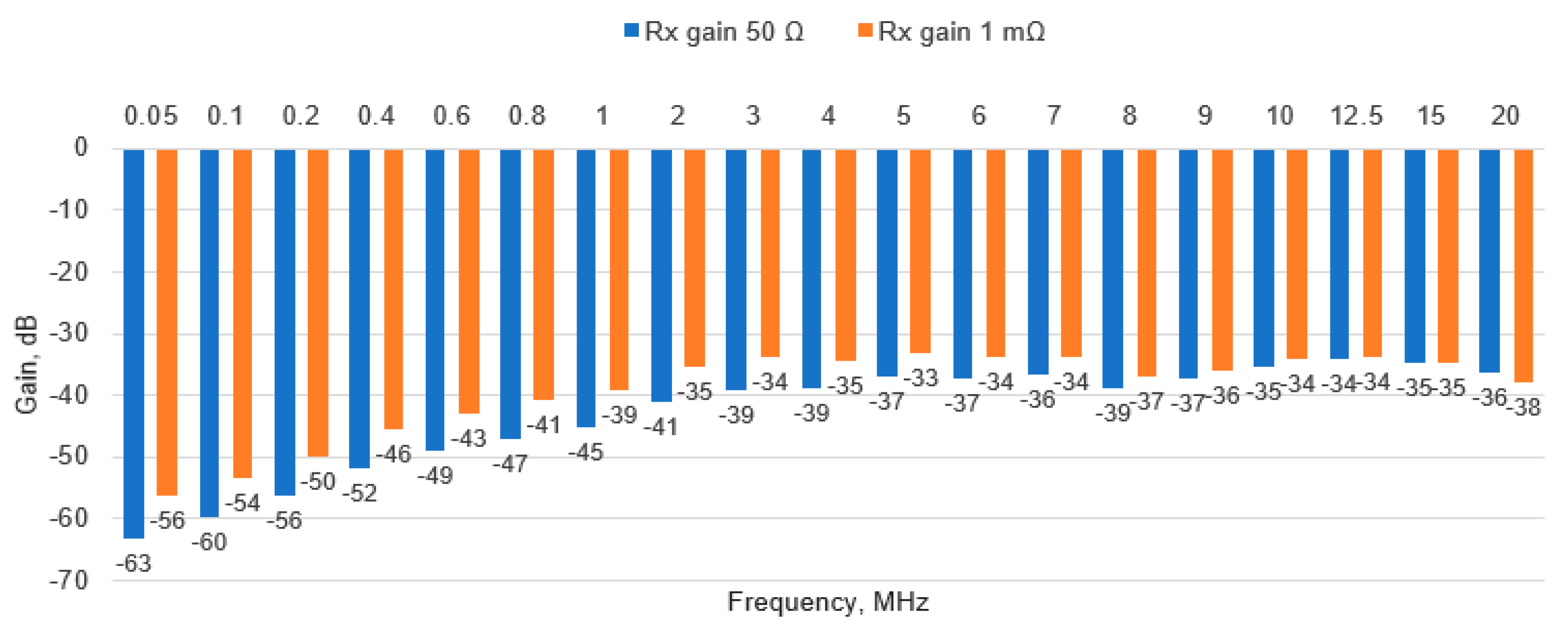
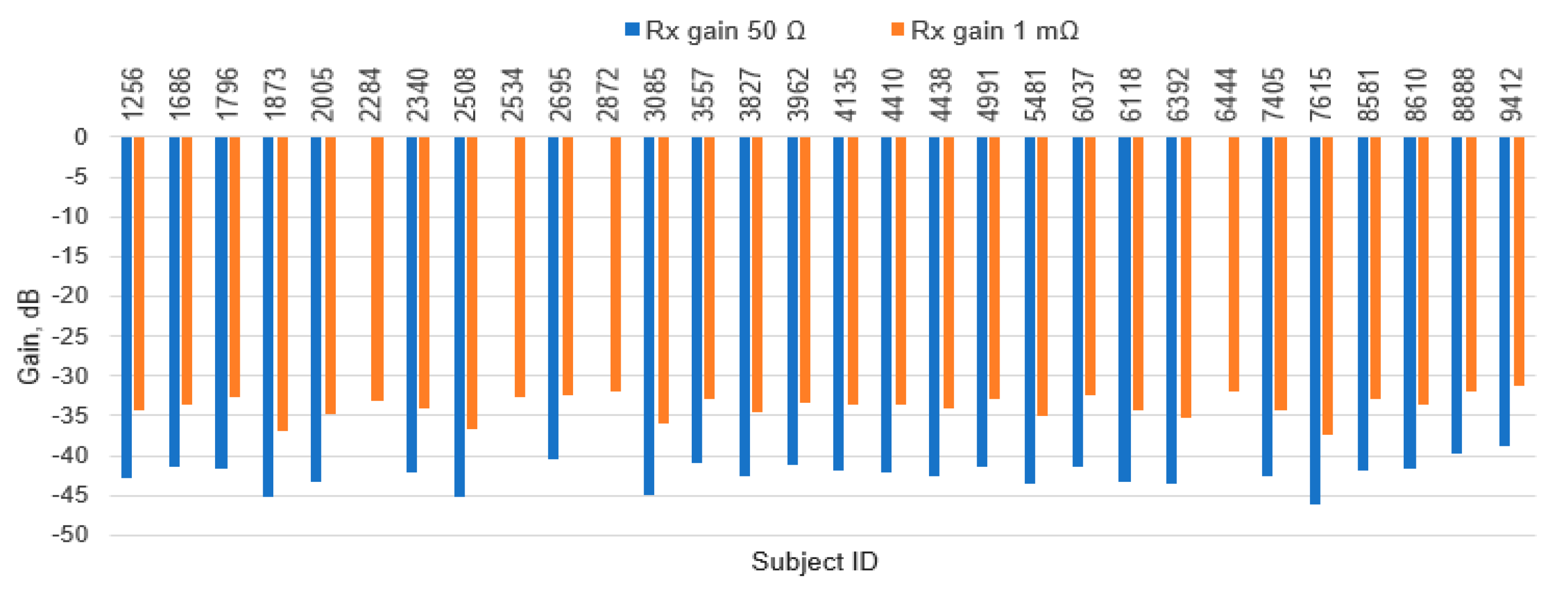
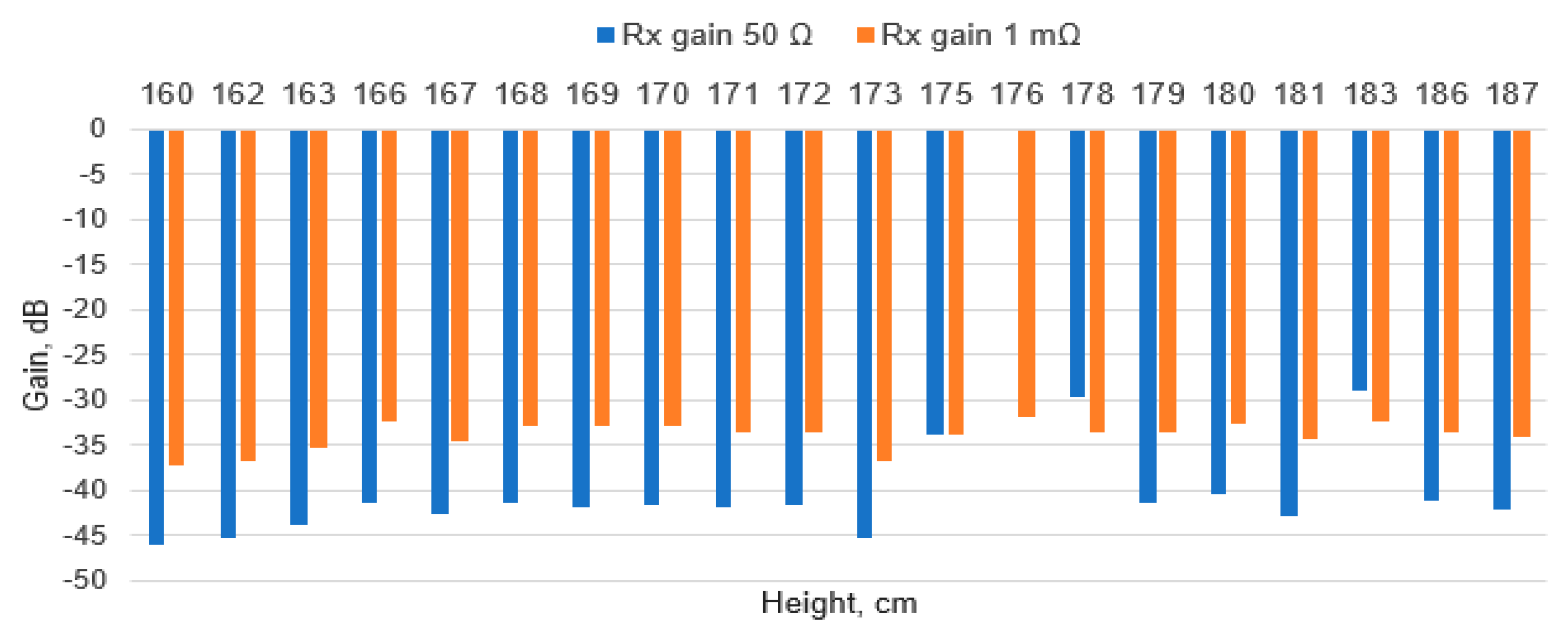
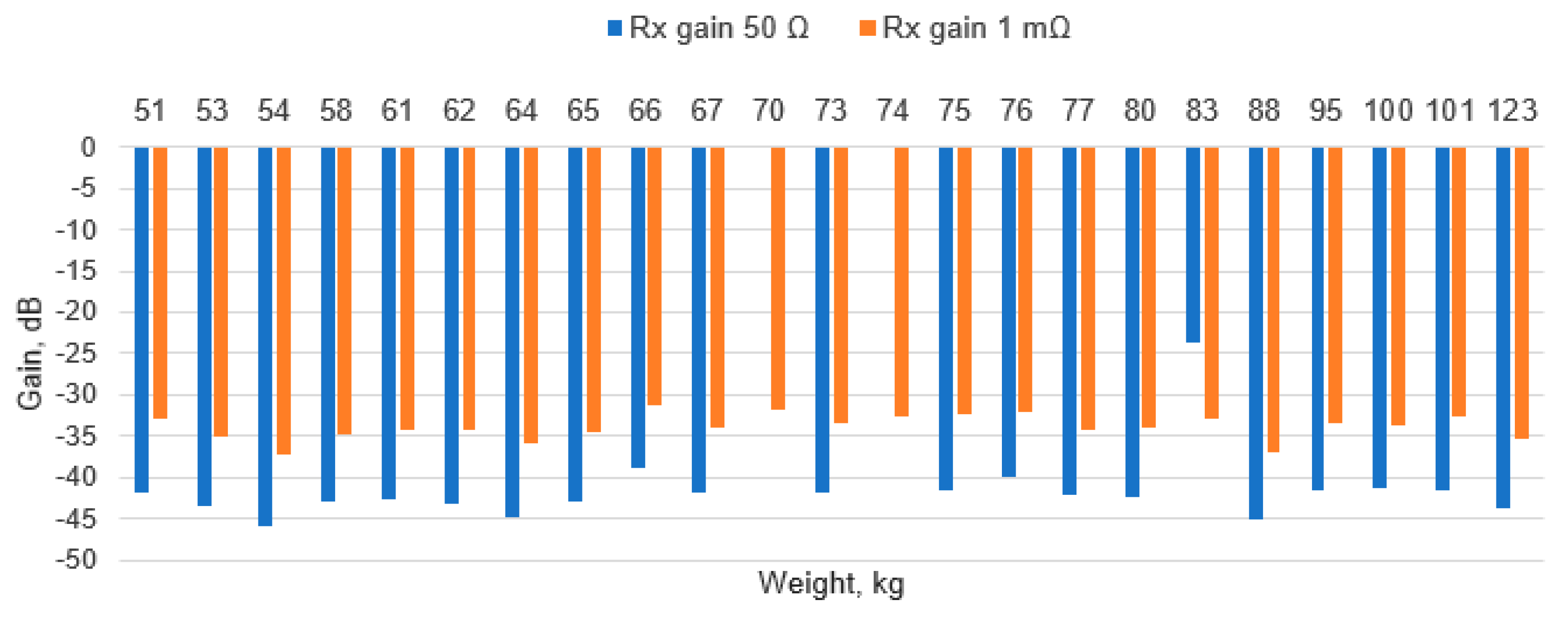

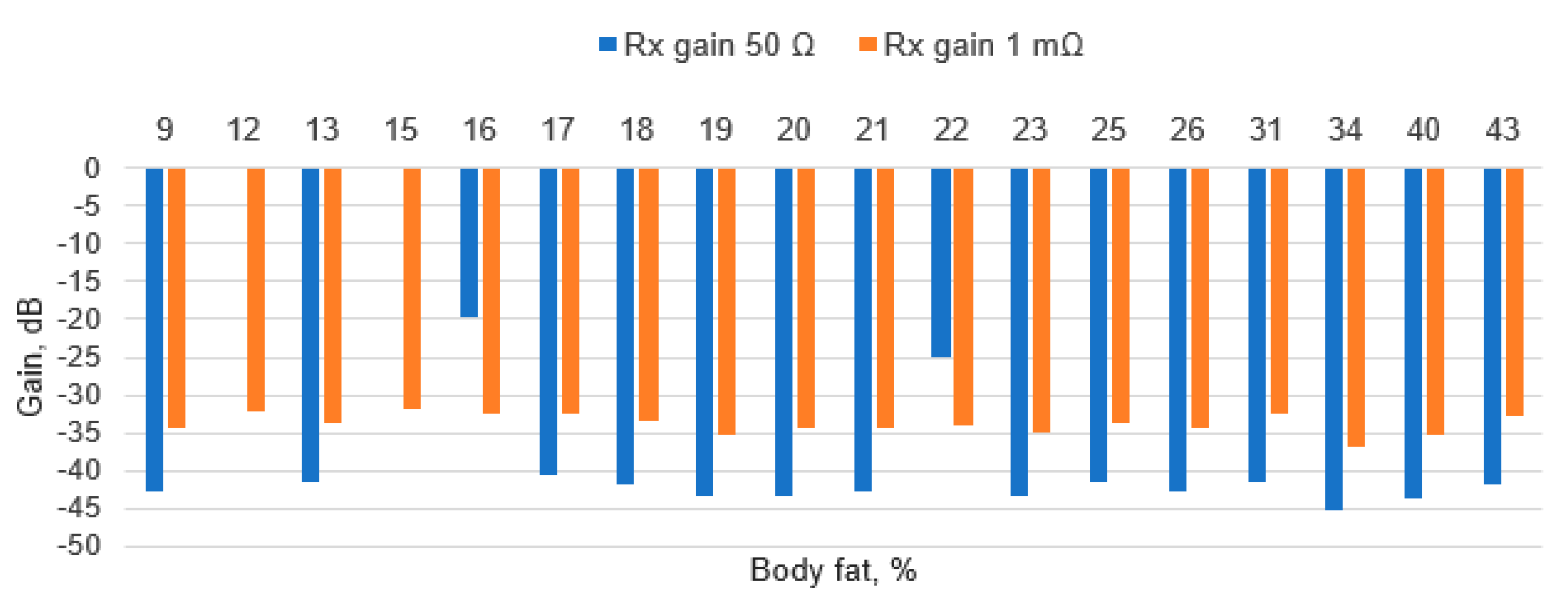
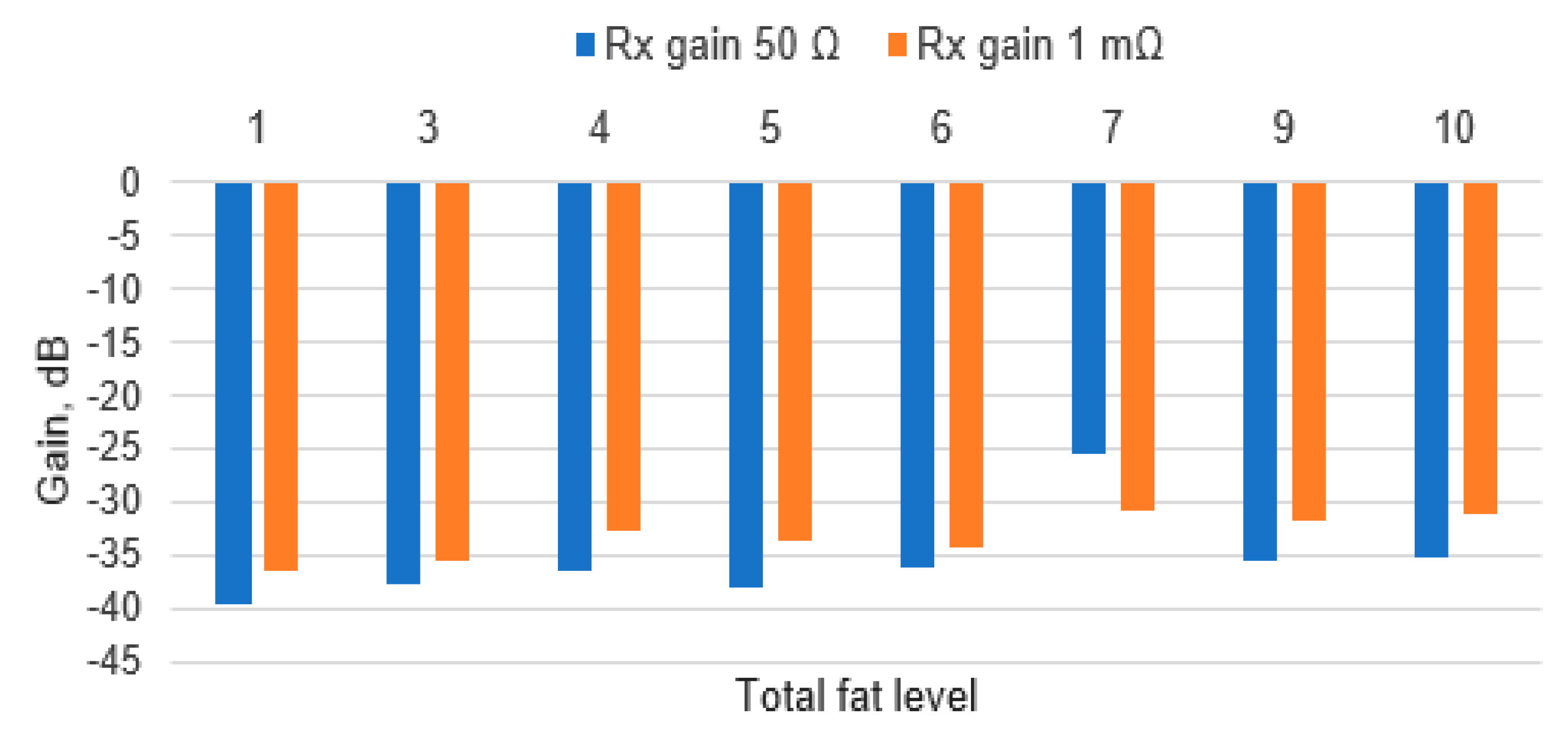



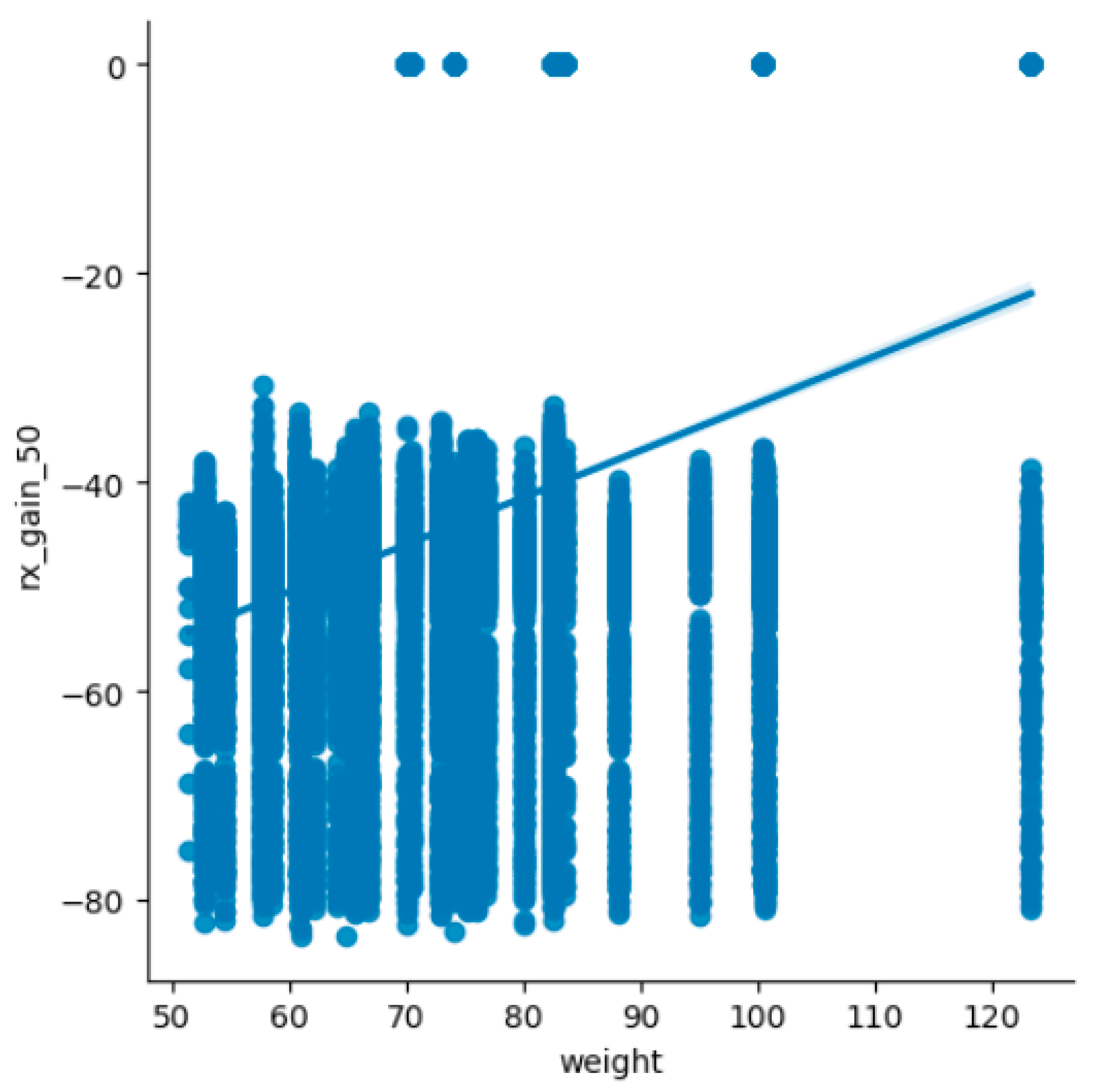
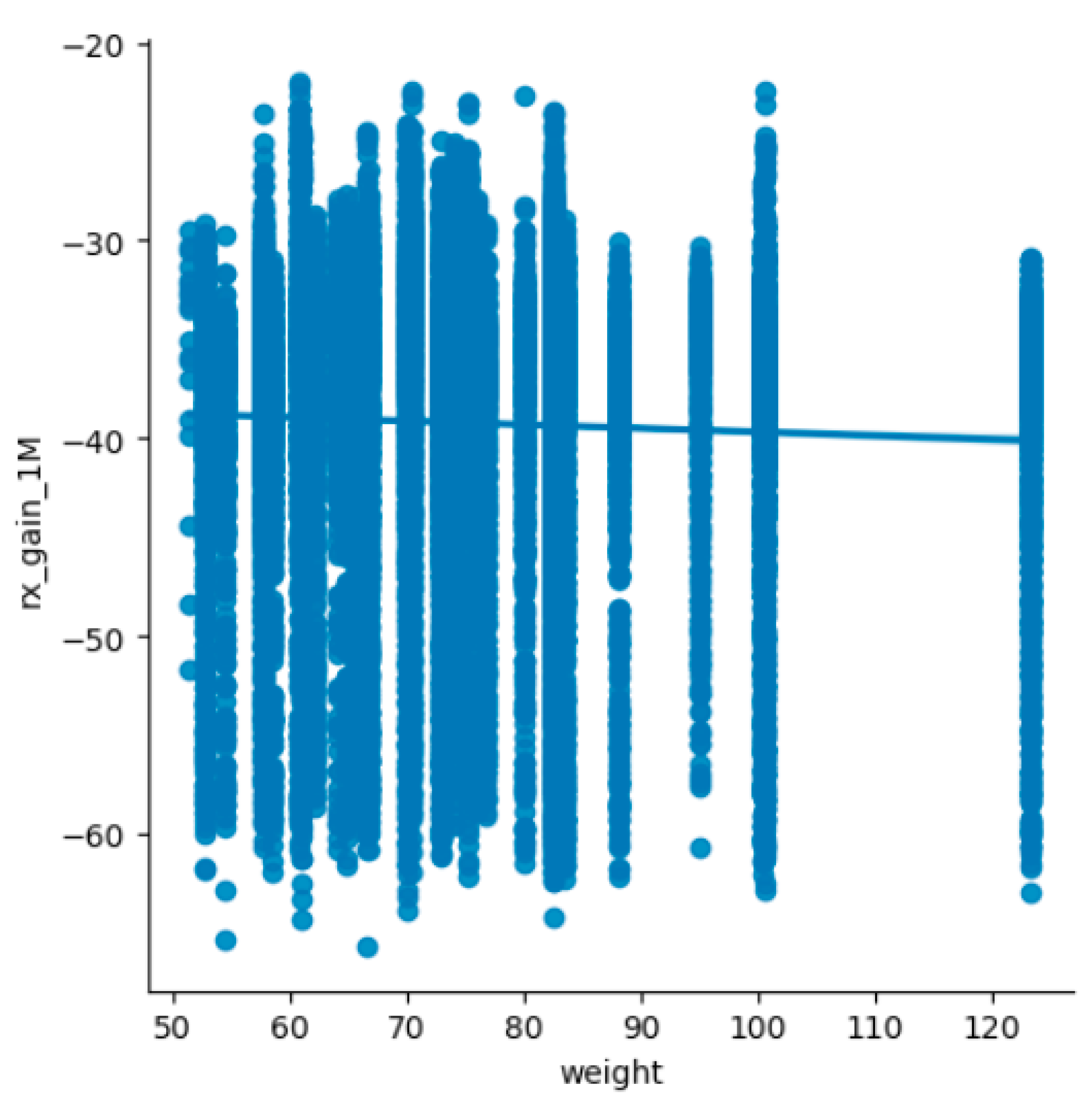
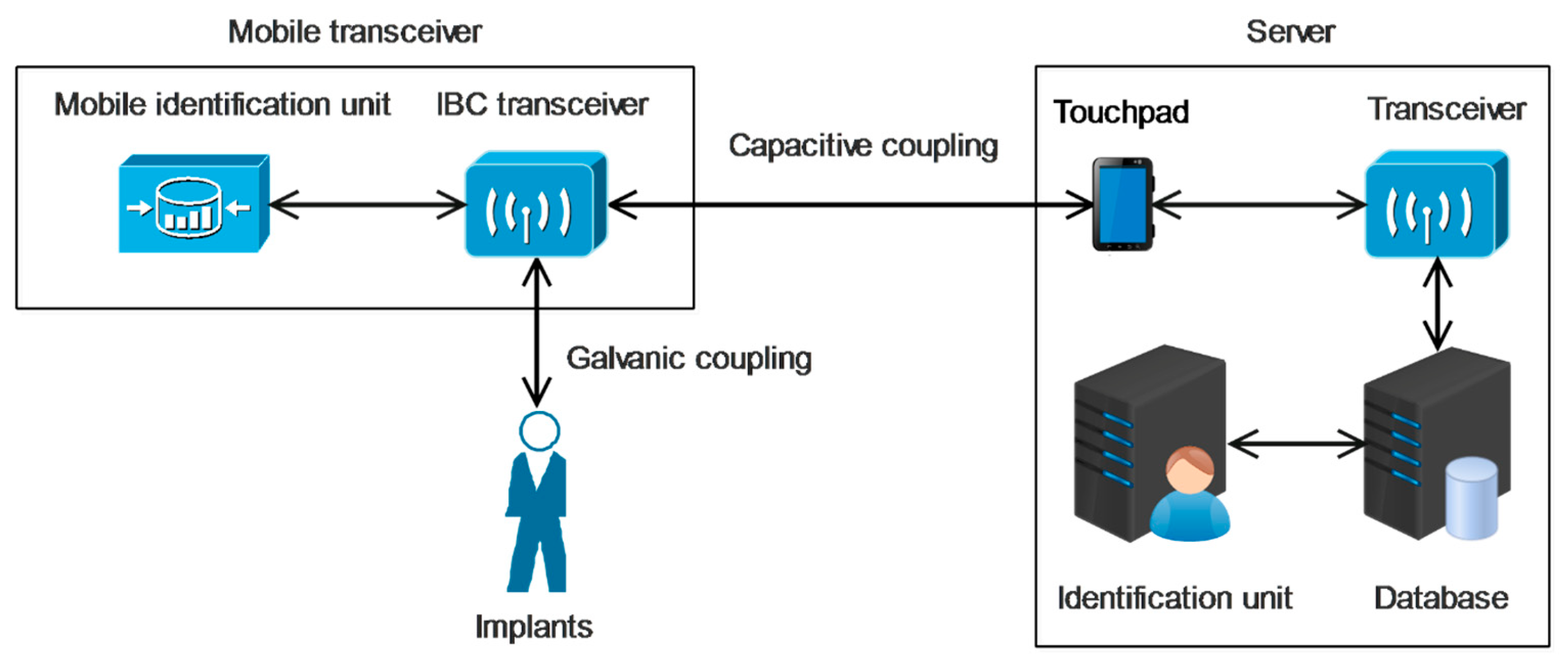
| Subject_id | Distance | Rx_gain_50 | Rx_gain_1M |
|---|---|---|---|
| 1256 | 20.6 | −47.771266 | −39.482652 |
| 1256 | 16.3 | −44.810831 | −36.444843 |
| 1256 | 13.6 | −44.475018 | −35.952138 |
| 1256 | 16.3 | −48.714588 | −40.176981 |
| 1256 | 14.9 | −44.007403 | −35.684326 |
| 1256 | 12.9 | −42.942264 | −34.625295 |
| 1256 | 8.6 | −37.340486 | −29.146415 |
| 1256 | 8 | −38.88304 | −30.088628 |
| 1256 | 6.7 | −38.236727 | −29.62718 |
| 1256 | 10.25 | −43.56398 | −34.519372 |
| 1256 | 5.5 | −37.712044 | −29.149732 |
| 1256 | 18.6 | −44.371963 | −35.712716 |
| 1256 | 13 | −42.146326 | −33.774958 |
| 1256 | 10.3 | −41.808655 | −33.768054 |
| 1256 | 4.15 | −47.139468 | −39.070489 |
| 1256 | 11.6 | −41.295583 | −33.238293 |
| 1686 | 16.3 | −43.848785 | −35.944426 |
| 1686 | 13.6 | −43.064913 | −35.35695 |
| 1686 | 16.3 | −45.95929 | −37.969667 |
| … | … | … | … |
Disclaimer/Publisher’s Note: The statements, opinions and data contained in all publications are solely those of the individual author(s) and contributor(s) and not of MDPI and/or the editor(s). MDPI and/or the editor(s) disclaim responsibility for any injury to people or property resulting from any ideas, methods, instructions or products referred to in the content. |
© 2025 by the authors. Licensee MDPI, Basel, Switzerland. This article is an open access article distributed under the terms and conditions of the Creative Commons Attribution (CC BY) license (https://creativecommons.org/licenses/by/4.0/).
Share and Cite
Khromov, I.; Voskov, L.; Komarov, M. Modeling and Analysis of Intrabody Communication for Biometric Identity in Wireless Body Area Networks. Appl. Sci. 2025, 15, 4126. https://doi.org/10.3390/app15084126
Khromov I, Voskov L, Komarov M. Modeling and Analysis of Intrabody Communication for Biometric Identity in Wireless Body Area Networks. Applied Sciences. 2025; 15(8):4126. https://doi.org/10.3390/app15084126
Chicago/Turabian StyleKhromov, Igor, Leonid Voskov, and Mikhail Komarov. 2025. "Modeling and Analysis of Intrabody Communication for Biometric Identity in Wireless Body Area Networks" Applied Sciences 15, no. 8: 4126. https://doi.org/10.3390/app15084126
APA StyleKhromov, I., Voskov, L., & Komarov, M. (2025). Modeling and Analysis of Intrabody Communication for Biometric Identity in Wireless Body Area Networks. Applied Sciences, 15(8), 4126. https://doi.org/10.3390/app15084126










